Physical Address
304 North Cardinal St.
Dorchester Center, MA 02124
Thyroid eye disease (TED) is an orbital autoimmune process associated with autoimmune thyroid disorders that causes inflammation and expansion and fibrosis of orbital fat and striated muscle, resulting in cosmetic and functional morbidity.
Approximately 50% of patients with Graves’ disease may develop orbitopathy.
The orbital target of the immune response is the pluripotential orbital fibrocyte.
Common clinical features of the orbitopathy are eyelid retraction, periorbital soft tissue congestion, proptosis, restrictive strabismus, and dysthyroid optic neuropathy.
Management is medical during the active inflammatory phase and surgical during the chronic fibrotic phase.
Thyroid eye disease (TED) is an orbital inflammatory disorder that is associated with thyroid autoimmune diseases and causes expansion and scarring of orbital fat and striated muscle.
Although it is self-limited, TED may significantly disrupt cosmesis, vision, and quality of life (QOL).
TED is the most common orbital disease globally, with a prevalence rate estimated between 0.5% and 2%, and with females outnumbering males by 4:1. It usually occurs between the second and sixth decade of life and involves all races.
Risk factors for developing TED include a positive family history, smoking, life stressors, and poorly controlled hypothyroidism after radioactive iodine. Predictors for more serious involvement by TED include male sex, increasing age, smoking, and a rapid onset of orbitopathy.
Cigarette smoking is strongly correlated with both the development of TED and with its severity.
Patients with TED have an increased probability of developing associated immune diseases, including superior limbic keratitis, myasthenia gravis, diabetes mellitus, alopecia, and vitiligo.
TED often occurs in conjunction with autoimmune thyroid diseases, such as Graves' disease (90%) or Hashimoto thyroiditis (3%); 90% of orbitopathy patients have current or previous abnormal systemic thyroid hormone levels, whereas others may develop abnormal levels in the future.
In Graves’ disease, an aberrant population of lymphocytes produce thyrotropin-receptor antibodies, also known as thyroid-stimulating hormone receptor (TSH-R) antibodies. Differing subtypes may cause more, less, or unchanged levels of serum thyroxine.
Similar receptor sites on skin and orbital fat and muscle fibrocytes also may be targeted by these autoantibodies in Graves' disease, resulting in orbitopathy in 50% and dermopathy (pretibial myxedema or acropachy) in 5%–10%.
The target cell in TED is the CD34 + pluripotential orbital fibrocyte, present in orbital fat, striated muscle, and lacrimal gland. These cells have increased thyrotropin receptors (TSH-Rs) and insulin-like growth factor receptors in close apposition on their surface. Binding of circulating thyrotropin-receptor antibodies to these fibrocyte receptors may cause cross-talk, which induces adipogenesis and hyaluronic acid production, resulting in expansion and remodeling of orbital tissues. The process is enhanced by activation of T helper cells with the release of cytokines (including interleukin-16) that potentiates the inflammatory cascade ( Fig. 12.13.1 ).
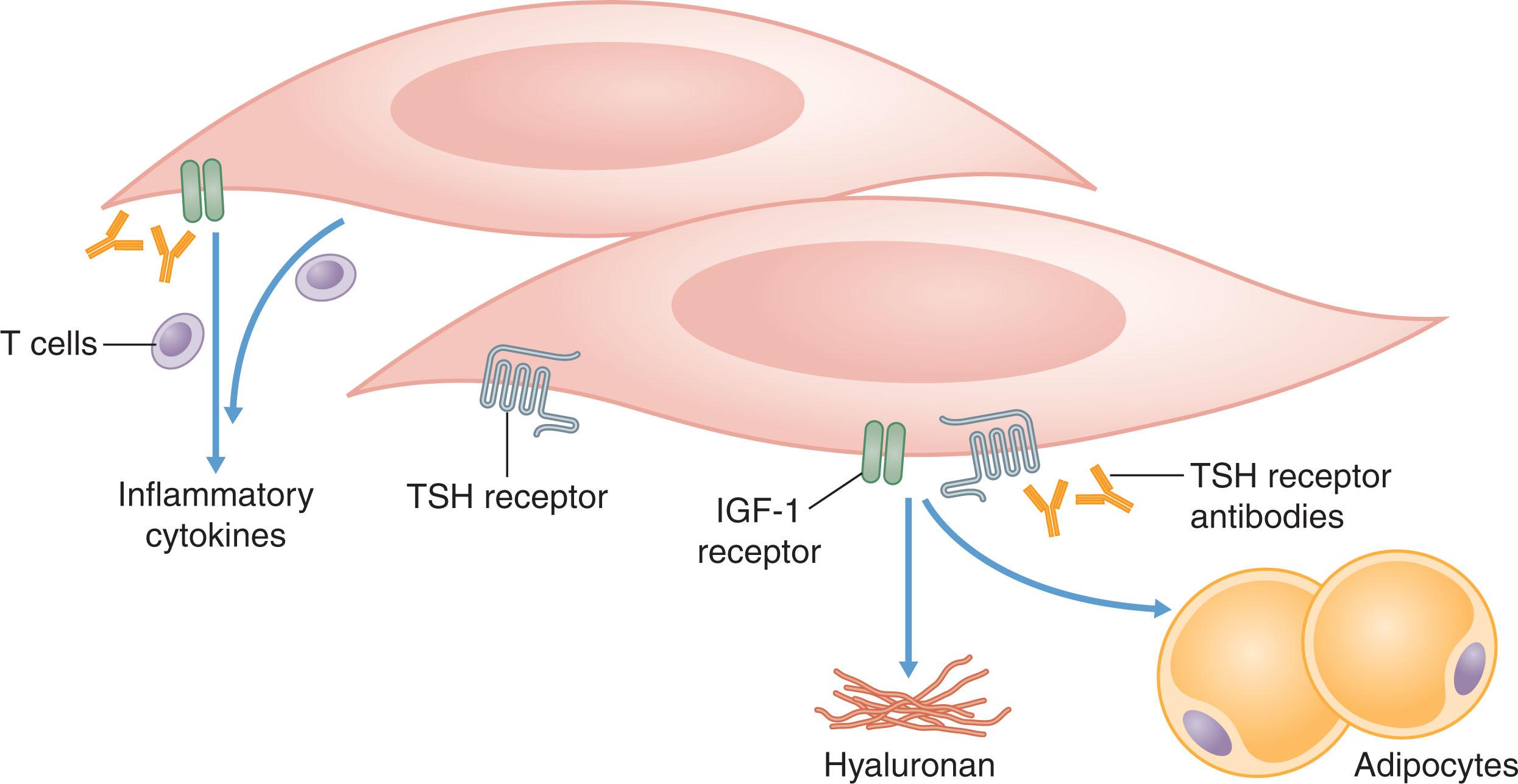
TED presents with a spectrum of clinical features determined by which orbital tissues are involved. The pattern and extent of involvement are graded as “disease severity.”
Approximately two-thirds of patients with TED develop primarily fat expansion, often in association with focal levator muscle inflammation, resulting in eyelid retraction, proptosis, and ocular exposure. This pattern typically evolves indolently in a younger, predominantly female population ( Fig. 12.13.2 ).
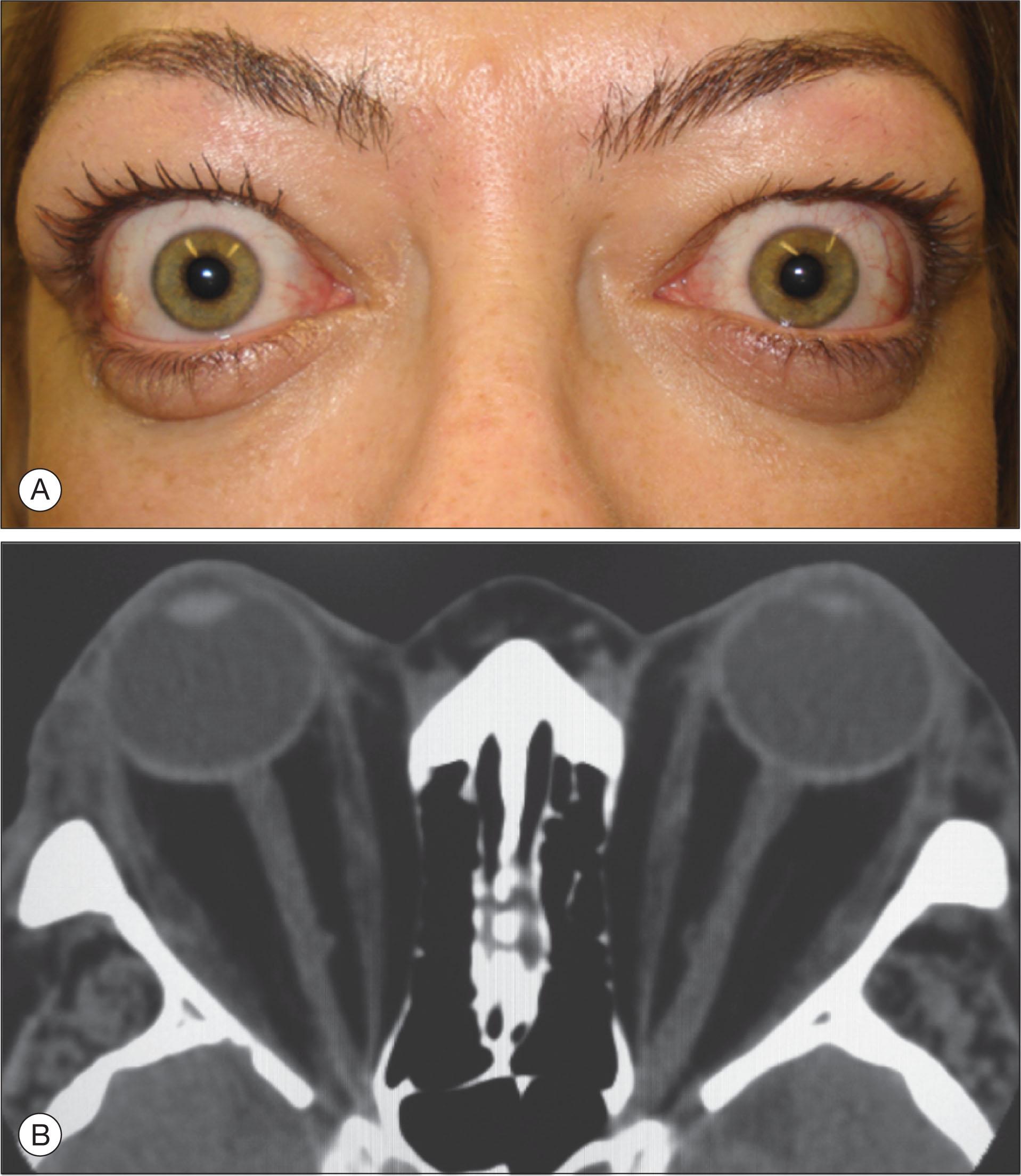
The remaining third have significant enlargement of one or more extraocular muscles and present with more severe features, including congestion and edema of the conjunctiva and eyelids, restricted ocular ductions with diplopia, and dysthyroid optic neuropathy (DON) resulting from apical compression of the optic nerve by the swollen muscles. Muscle-centric disease usually develops more rapidly in an older population with a more balanced sex distribution and is more likely to be associated with smoking and a positive family history of TED ( Fig. 12.13.3 ).
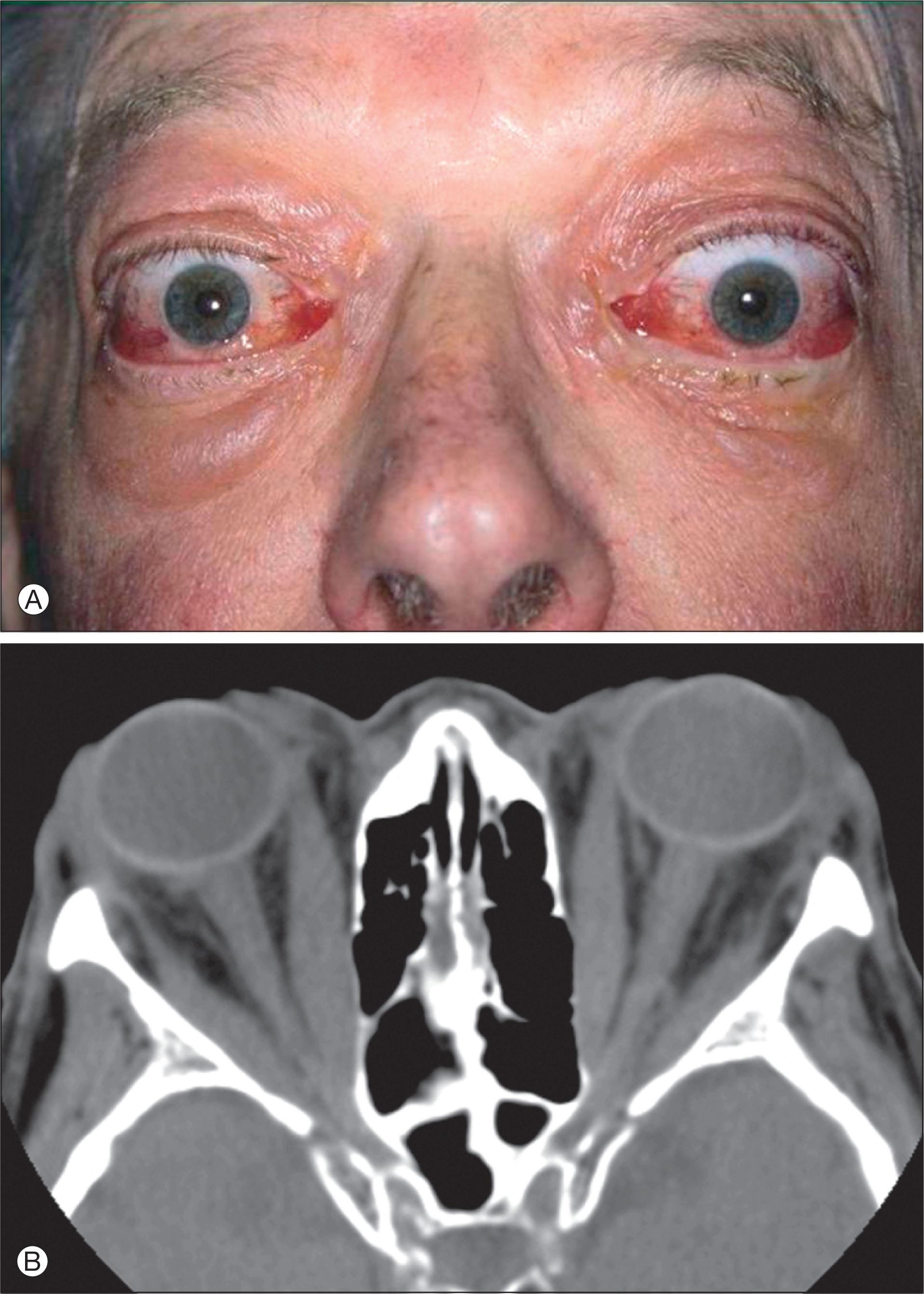
TED has a biphasic course, with a progressive (“active”) phase lasting 6–18 months, followed by a stable (“inactive”) phase. These disease phases are graded as “clinical activity.” “Rundle's curve” is a graph of orbital disease severity against time ( Fig. 12.13.4 ), with a steeper slope in the progressive phase reflecting more aggressive disease. Immunomodulators and radiotherapy (RT) administered during the early active phase may limit the destructive consequences of the immune cascade. Surgery is usually performed in the postinflammatory phase for orbital cosmesis, comfort, and function but may be needed during the progressive phase to prevent vision loss from DON or corneal breakdown.
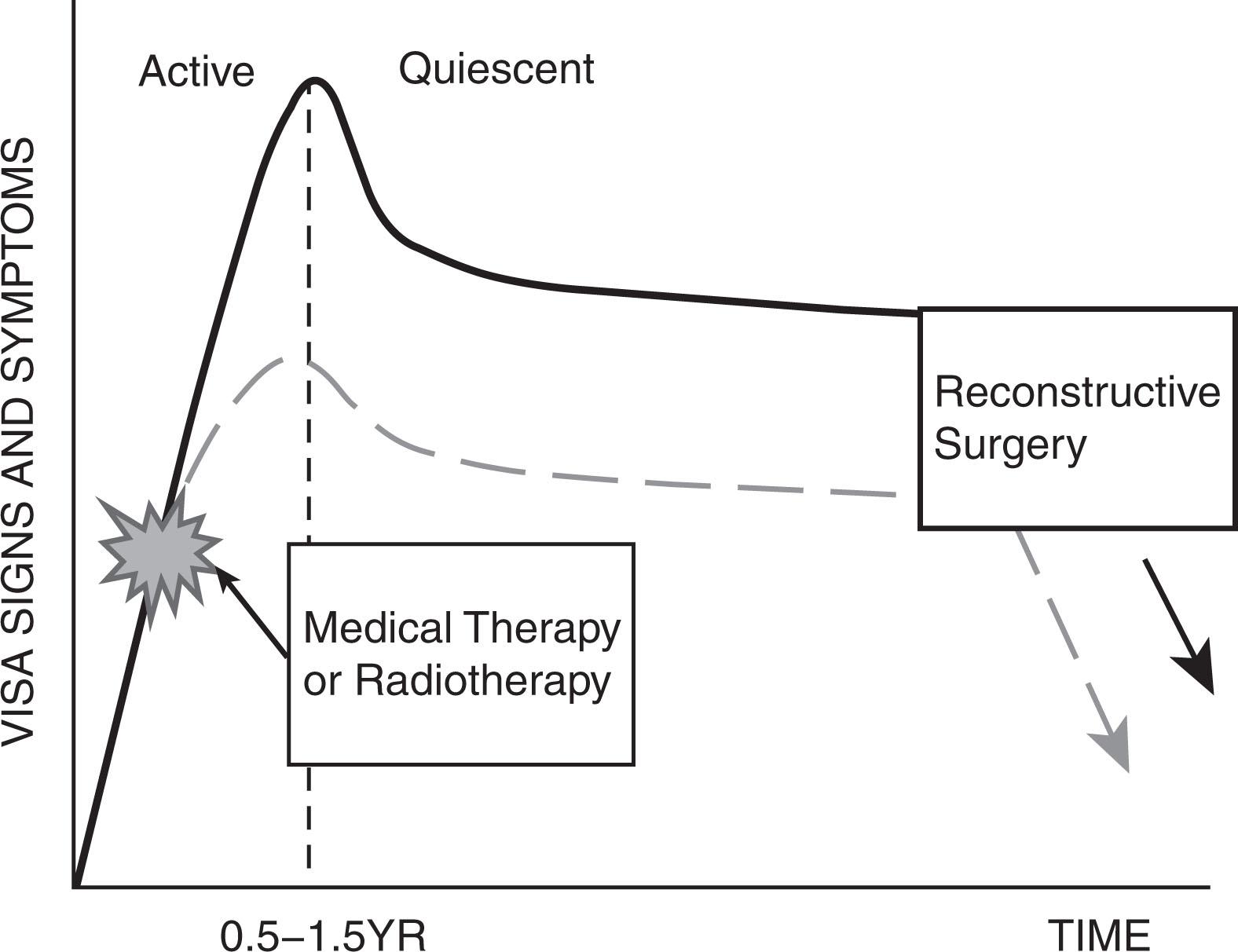
Recurrence of TED occurs in less than 10% of cases.
Diagnosis of TED is based on three aspects of the disease:
Clinical features: Characteristic findings such as lid retraction combined with proptosis and limited motility are highly suggestive of TED, particularly when bilateral.
Thyroid function and antibody tests: Abnormal thyroid function tests (thyroxine and TSH levels) or a history of thyroid dysfunction help confirm the diagnosis, although 10% of TED patients may be euthyroid at onset. The presence of TSH-R antibodies has high sensitivity for active Graves’ disease.
Orbital imaging: CT or magnetic resonance imaging (MRI) may help confirm the diagnosis, particularly for atypical or uncertain clinical situations. CT scan documents fat or muscle enlargement and apical crowding, and allows assessment of bony walls and sinuses for possible surgical decompression. Contrast CT scans may show enhancement of the extraocular muscle sheaths or stranding of surrounding orbital fat in the active inflammatory phase or lucent spaces in the extraocular muscles in the inactive phase. MRI identifies edema within the extraocular muscles on T2 or STIR (Short Tau Inversion Recovery) sequence in active disease.
Early diagnosis permits an accurate evaluation of TED, including assessment of disease severity and activity and identification of those individuals at high risk of developing more serious complications.
The European Group on Graves’ Orbitopathy TED severity scale is based on three management categories. Mild disease includes lid retraction, mild proptosis, and minimal muscle involvement and is usually treated conservatively. Moderate to severe disease incorporates individuals with greater proptosis, inflammation, or motility restriction interfering with ability to function and is often treated medically. Very serious disease refers to sight-threatening conditions, such as DON or corneal ulceration, and may necessitate urgent surgical intervention. In this system the distinction between mild and moderate disease is imprecise, and the moderate class is a broad, heterogeneous category, including individuals with soft tissue congestion, motility disturbances, and severe proptosis, which might lead to imprecise choice of therapy.
Determination of activity in lipogenic TED with an indolent onset may be challenging, but these cases often are referred in a stable phase when surgery can be offered on a nonurgent basis. Myopathic TED has a more obvious progression through the active and inactive phases, with the expanding muscles causing periocular congestion highlighting that the disease is more likely to lead to significant visual impairment from diplopia or DON.
The Clinical Activity Score (CAS) uses a binary score to assess five periocular soft tissue congestive features and two pain symptoms as surrogate markers of inflammation and was designed to identify TED that would respond to immunosuppressive therapy ( Box 12.13.1 ). On follow-up visits, additional points are given for increased proptosis (≥2 mm), decreased ocular motility (≥8°), or decreased visual acuity over the previous 3 months. A CAS of ≥4 has an 80% positive predictive value and a 64% negative predictive value for response to corticosteroid (CS) therapy. However, there is no proof that it correlates with risk of developing significant complications, such as diplopia or DON, and is limited by significant false-positive and -negative cases.
For initial Clinical Activity Score, only score items 1–7.
Spontaneous orbital pain
Gaze-evoked orbital pain
Eyelid swelling that is considered to be due to active (inflammatory phase) Graves’ orbitopathy (GO)
Eyelid erythema
Conjunctival redness that is considered to be due to active (inflammatory phase) GO
Chemosis
Inflammation of caruncle or plica
Patients assessed after follow-up between 1 and 3 months can be scored out of 10 by including items 8–10.
Increase of >2 mm in proptosis
Decrease in uniocular excursion in any field of gaze >8°
Decrease in visual acuity of >1 line on Snellen chart
Various laboratory studies (urine and serum glycosaminoglycans and TSH-R antibodies) and imaging techniques (contrast-enhanced CT, T2/STIR sequence MRI, octreotide scans, and facial thermography) have been used to quantify activity, but none has proved more reliable than subjective or objective clinical assessment of disease progression.
This recording form grades both disease severity and activity using subjective and objective inputs ( Fig. 12.13.5 ). It organizes the clinical features of TED into four severity parameters: V (vision, DON); I (inflammation, congestion); S (strabismus, motility restriction); and A (appearance, exposure). A summary grade for each severity parameter is recorded at the end of the form so that directed therapy is chosen depending on the parameters most involved.
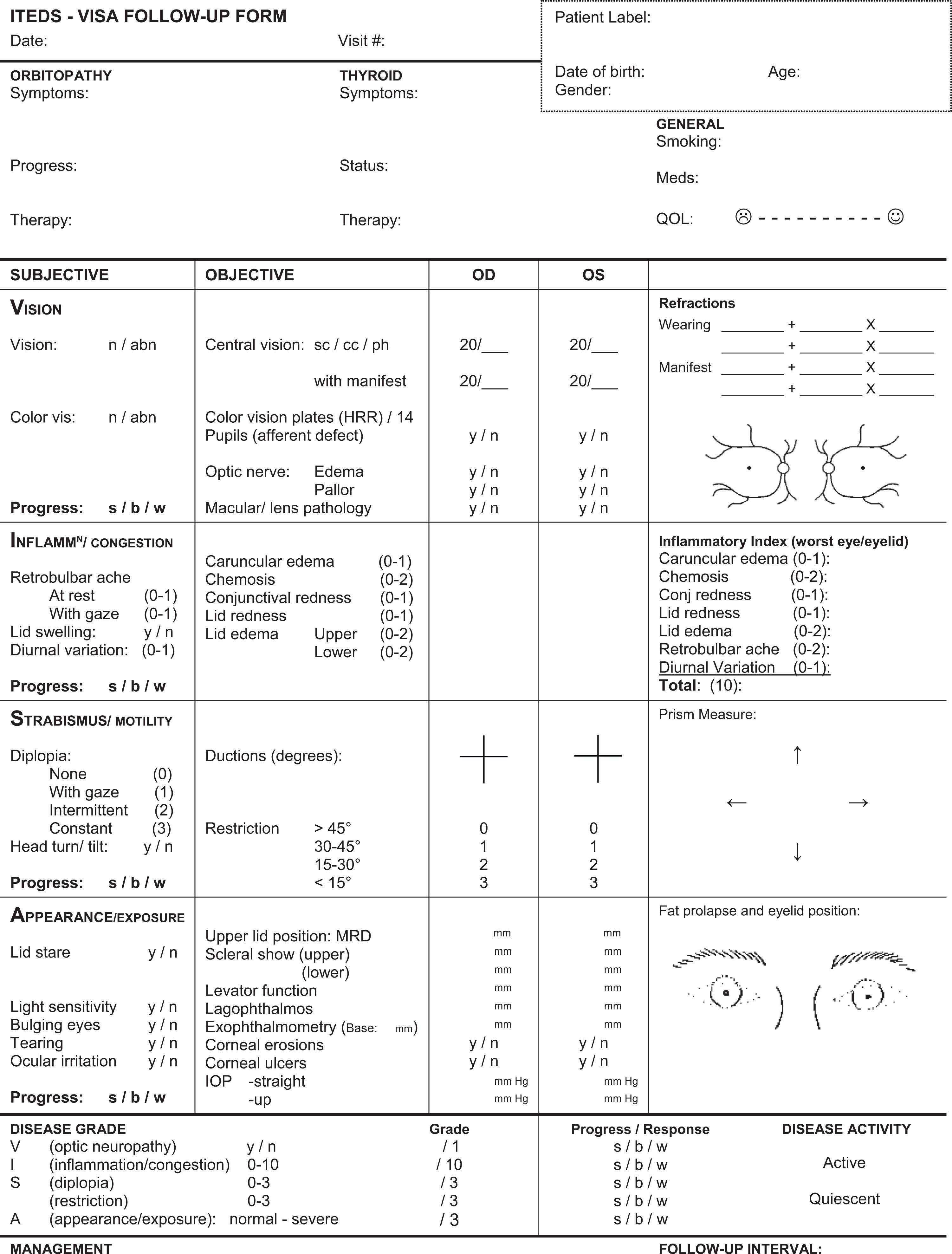
Activity is based not on the inflammatory score but by subjective or objective evidence of progression for any of the four severity parameters since the previous visit.
The layout follows the usual sequence of the eye examination and facilitates comparison of measurements between visits, as well as data collation for research.
On the first visit, the date and rate of onset and historic progress of both the systemic and orbital symptoms are recorded, defining characteristics of the disease course. Additional questions also determine risk factors for more serious TED outcomes associated with extraocular muscle involvement, including smoking, family history, and diabetes. A first-visit form (two pages) and follow-up form (one page) may be downloaded from the International Thyroid Eye Disease Society website ( http://thyroideyedisease.org/ ).
Become a Clinical Tree membership for Full access and enjoy Unlimited articles
If you are a member. Log in here